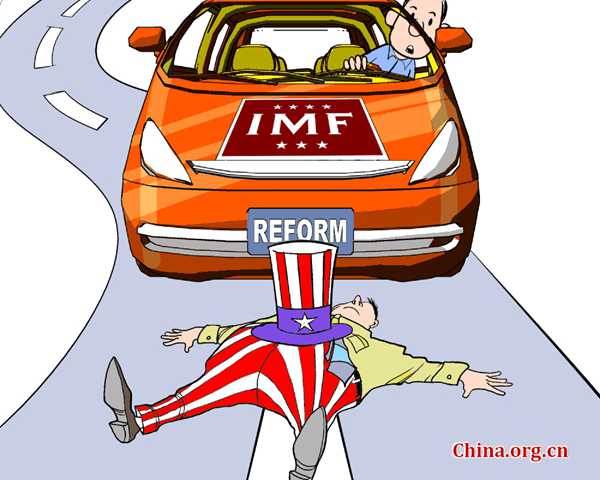Prospects for 'new normal' of US economy
- By Yu Xiang
 0 Comment(s)
0 Comment(s) Print
Print E-mail China.org.cn, September 6, 2015
E-mail China.org.cn, September 6, 2015
|
|
|
Never letting go [By Jiao Haiyang/China.org.cn] |
The United States economy began to pick up at an expansionary pace in the second quarter of 2009, but the recovery showed features distinctively different from previous economic rebounds. From a medium- and long-term perspective, the recovery, which has evolved in a non-traditional model, could easily develop into a "new normal" for the US economy.
First, the real economy, with manufacturing at the core, started to expand, but the overall economy was characterized by only moderate growth.
The 2008 global financial crisis has exposed the real problem with the US economy. To retool the economic structure, the US government gave top priority to development of the real economy. One important measure was the strategy of "Accelerating US Advanced Manufacturing." The US government hoped to achieve the effect of "killing two or more birds with one stone" through the strategy: in the short term, to stimulate the economic recovery and relieve pressure of worsening unemployment; in the medium term, to achieve economic structural adjustments, foster new growth engines and promote the economic rebalancing; and in the long term, to seek a dominant role and resharpen its competitive edge in the world by cashing in on a new round of industrial revolution. To date, the US manufacturing industry has gained strong momentum for expansion and rejuvenation. One indicator is that the output value of the manufacturing industry has increased remarkably. From 2010 to 2014, the growth rate of manufacturing output value averaged 4 percent, higher than GDP growth in the same period. In May 2015, capacity utilization rose to 78.1 percent, the highest level since February 2008. Another indicator is that manufacturing has become increasingly competitive, compared with other industries. From 2010 to 2013, the growth rate of per-capita output value of the manufacturing industry was 3.9 percent, much higher than per-capita growth level for all industry (1.9 percent). The third indicator is that US companies abroad have started to return home. According to a survey of 108 US manufacturing companies with global operations, conducted by Massachusetts Institute of Technology, about 14 percent have started to move their factories and plants back to the US, and one-third are considering this option.
The overall growth of the US economy, however, was relatively moderate. The recovering pace of the US economy since 2009 has hovered at a level lower than the 3 percent to 4 percent growth before the global financial crisis, and also much slower than the recovering speed registered in the 1950-60 and 1995-2001 periods. In the first quarter of 2014, the US economy witnessed negative growth of 2.1 percent due to extreme weather conditions, and in the first quarter of 2015, growth slowed again due to the impact of harsh winter weather and the appreciation of the dollar. The volatile fluctuation of the economy, to some extent, is a reflection of vulnerability of the US economy, and the driving effect from the real economy recovery, with manufacturing industry at the core, is weakening.
Second, the loose monetary policy did not unleash a surge in inflation.
To cope with the financial crisis, the US Federal Reserve launched three rounds of massive quantitative easing, leading the national balance sheet to swell to US$4.5 trillion, but the consumer price level had stayed below the warning line of 2 percent. What really concerned people about the economy was the risk of deflation, not inflation. Secret documents accidentally leaked by the Fed on June 26 showed that Fed researchers believed the US economy will continue to be under deflationary pressure, and the inflation level will stay below the 2 percent target through the end of 2020. On July 15, the Summary of Commentary on Current Economic Conditions by the Federal Reserve, commonly known as the Beige Book, also said signs of inflation are still relatively weak, and there is only minor pressure for wage hikes. Against the backdrop of the economy bottoming out, ample liquidity and an easing monetary policy, inflation still remained at a moderate level, and this is an economic phenomenon rarely seen in the US history.







Go to Forum >>0 Comment(s)